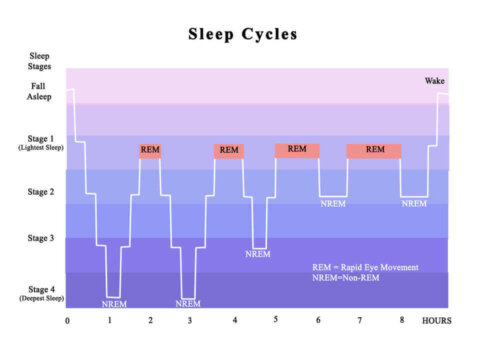Understanding the Four Stages of Sleep

The stages of sleep are the periods in which changes occur while we’re actually asleep. Many people believe that we’re basically in a state of lethargy during this period of time. It isn’t so, though. In fact, several processes take place during sleep and every stage has certain characteristics.
Medical tests such as electroencephalogram, electromyography, and electrooculogram confirm the presence of the different stages of sleep. The changes in the electrical conductivity of the skin, the respiratory rhythm, and the heart rate, in each phase, are observable through these.
Some people don’t go through all the phases of sleep, and, thus, wake up tired and feel sleepy during the day. This gives rise to different problems. As you can see, it’s important to complete the sleep cycle in order to maintain mental and physical balance.
General characteristics of the four stages of sleep

Sleep isn’t a linear process, but a cyclical one. In other words, there are several phases that follow one another sequentially. It begins with a numbing state until you reach your deepest sleep. It then returns to the initial point and the cycle repeats.
Each full sleep cycle lasts between 90 and 100 minutes for most people. We usually have between four and six cycles during a normal rest period throughout the night. The order the different phases of sleep occur in is always the same.
In principle, sleep is divided into two major stages. The first one is the slow sleep phase or non-REM sleep phase; the second one is the fast sleep phase or REM sleep. The word REM stands for Rapid Eye Movements.
Are you aware of The Impact of the Menstrual Cycle on Sleep?
The phases of slow sleep
The NREM (Non-REM) phase is called quiescent sleep because it corresponds to the stage in which the brain presents slow waves. It represents the stage of transition between the waking state and sleep. What predominates is a state of light sleep, with attenuated breathing.
You’re not properly asleep during this stage, only in a state of dreaming. You still hear the sounds of your environment and are only partially disconnected from what’s happening around you. This phase lasts about 15 minutes total — from the moment you close your eyes. However, you only have about five minutes of actual sleep.
Quiescent or NREM sleep is divided into four phases of sleep, each with its own characteristics; these are:
- Phase I or numbness. It lasts about 10 minutes and the muscle tone decreases, the eye movements become slow as well. There are hallucinations in some cases, at the beginning and end of this phase. It corresponds to 5% of the total sleep.
- Phase II or light sleep. Certain mechanisms activate in order to prevent awakening and the heart and respiratory rate decreases. Eye movements disappear and sleep begins to be restful, although not totally. This stage corresponds to approximately 50% of sleep.
- Phase III or transition to deep sleep. This is the shortest of all sleep phases and lasts between two and three minutes. The sensory block increases and the sleep is deeper. You’ll experience confusion if you wake up. There’s no dreaming during this stage.
- Phase IV or delta sleep. This phase lasts about 20 minutes and people rarely wake up during it. There’s no dreaming, only restorative rest that’s essential for the mind and body.
Read about Sleep Inertia: Why You Wake Up in a Bad Mood
The REM phase

This phase is also known as “paradoxical sleep,” and this is due to the contrast between the total relaxation of the muscles, characteristic of rest, and brain activity, characteristic of the waking state.
This is also the stage where we dream and perceive such images as real. People who wake up during this phase will clearly remember what they were dreaming — at least in 80% of people. You would try to act upon what you’re dreaming if you could move during this stage.
Finally, the REM phase occurs at different times during sleep and has a variable duration. It lasts about 10 minutes the first time it occurs and between 30 to 40 minutes the last time — during an eight-hour sleep. It begins with rapid and irregular breathing and then moves into a state of deep sleep.
All cited sources were thoroughly reviewed by our team to ensure their quality, reliability, currency, and validity. The bibliography of this article was considered reliable and of academic or scientific accuracy.
- Fernández-Mas, R., Valdés, A., Martínez, A., Magdaleno, V., Almazán, S., Martínez, D., & Fernández-Guardiola, A. (2013). Visualización gráfica de las transiciones de las fases del sueño en el hombre: métodos de representación tridimensional.
This text is provided for informational purposes only and does not replace consultation with a professional. If in doubt, consult your specialist.








